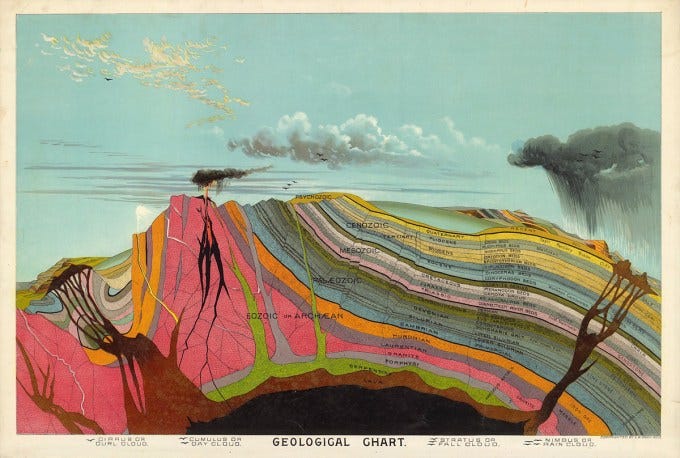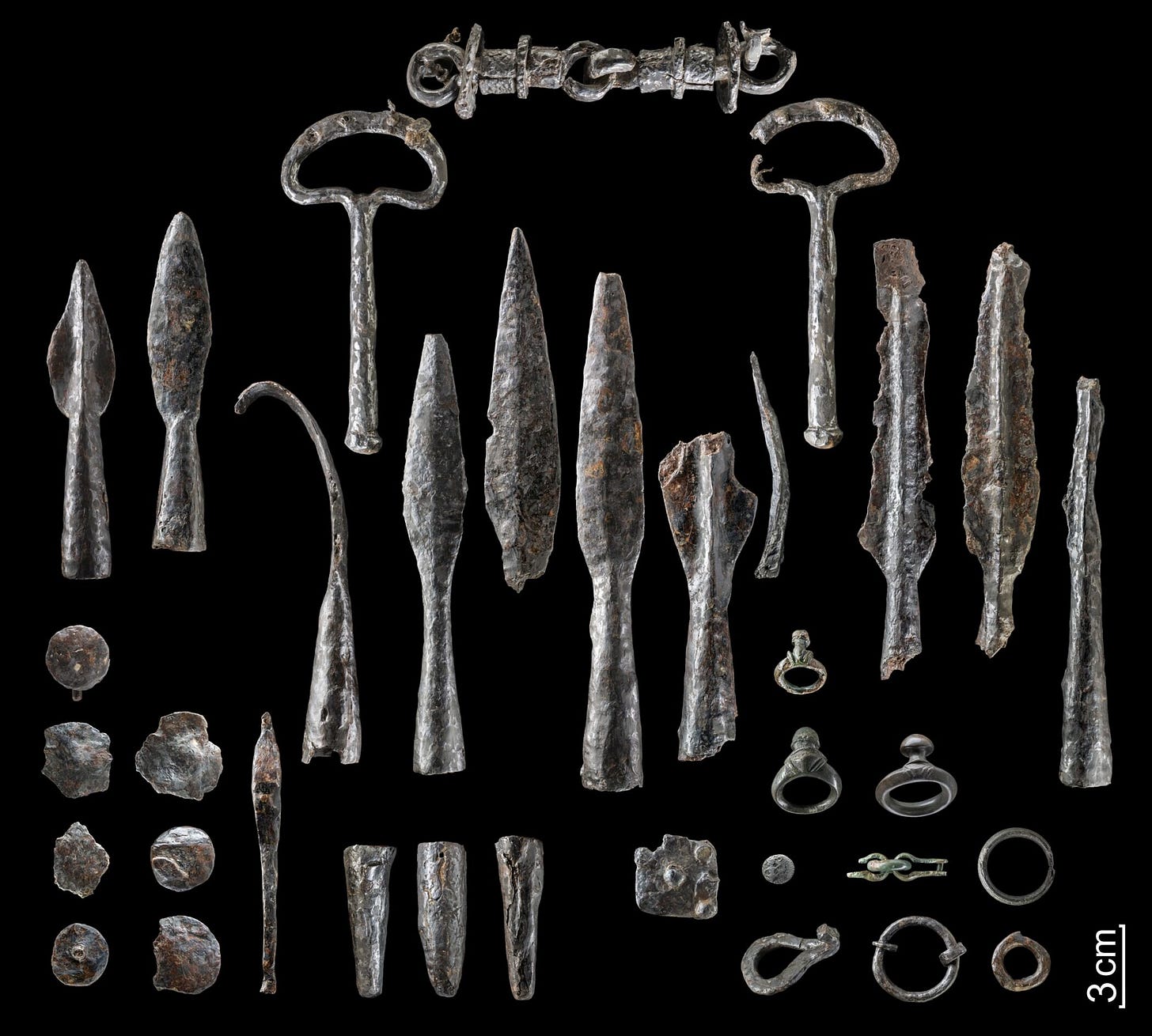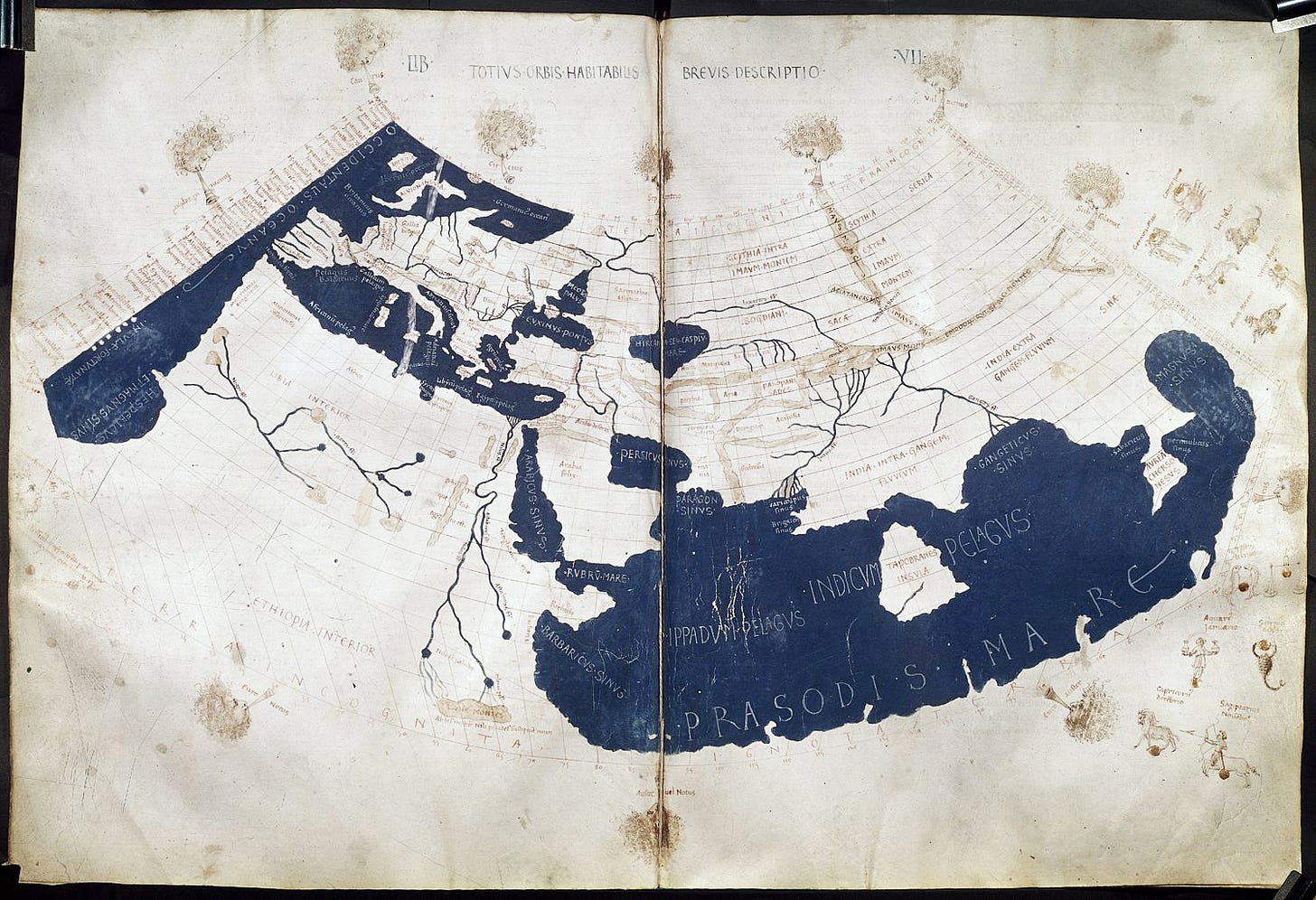"Geographical Portfolio,” Levi Walter Yaggy, 1887
Humans have been co-evolving with technology for a very, very long time, even on evolutionary timescales. The building and application of technology is arguable the defining feature of our species.
Our oldest technologies involved the recombination of fire, stone and metals which humans dug out of dirt bare handed. Much like the self-assembling and self-replicating complex carbon molecules in the prebiotic soup, early human technologies were replicated, encoded, and transmitted across early human networks, such as the Silk Road.
It’s not enough to discover scientific laws. Science is only theory until it is applied as technology.
The Birth of Technology (Hands + Stone)
Ancient human scavengers, indistinguishable from other animals, once dug through the dirt with their bare hands in search of food.
For a long time, they overlooked the rocks scattered on the ground, deeming them useless. After all, any creature that tried to consume such inorganic material would quickly suffer fatal consequences, like a bowel obstruction.
Early humans risked serious injury when striking objects too forcefully, as broken hand bones could drastically reduce their ability to grasp and manipulate objects—a potentially life-threatening injury.
But around 2.6 million years ago, humans discovered that they could reduce the risk of injury by using rocks to deliver stronger impacts. This realization allowed them to wield stones as tools, throwing and sharpening them with increasing accuracy and precision.
Technological leverage had been just laying on the ground waiting to be discovered.
And so, without ceremony, stone tools emerged.
The oldest known stone tools, Oldowan stone tools, discovered in modern day Ethiopia 2.6 million years ago
The discovery of stone tools introduced a revolutionary force-multiplying technology. Compared to the fragile human hand alone, the combination of an ape grip and the hardness of stone gave early humans a dramatic increase in striking power.
Since metallurgy had not yet been invented, tools made from pure elements (a single type of atom) were rare. Humans instead relied on rocks constructed from highly compressed elements called minerals.
The earliest stone tools were made from minerals harder than bone, capable of holding a sharp edge, and readily available within the top layer of the Earth’s crust. This was quartz, quartzite, basalt, or obsidian, and later flint. Obsidian, a naturally occurring volcanic glass that’s made up of silicon, oxygen, aluminum, sodium and potassium that could be picked up in chunks right off the ground, was crafted and sharped into the most advanced tools and weapons of the Paleolithic era.
By combining the cooperative power of early social networks with the force-multiplying effect of stone tools, humans began to outcompete every other animal on the planet. It was as if, overnight, humans had suddenly evolved lethal hands of stone.
With natural selection unable to keep pace, animals had no time to adjust to this rapid shift in the ecosystem’s power dynamics. Early stone technology made humans so powerful they hunted the colossal wooly mammoths to extinction. Soon humans dominated any ecosystem they entered, surpassing their stronger, faster, but less technologically advanced rivals.
Rouffignac Cave, France, Upper Paleolithic era, 13,000 BC
Fire and the Transmutation of Metal (Hands + Metal + Fire)
Fire has been integral to human existence for nearly a million years. Early humans captured and propagated fire from naturally occurring land wildfires.
The strategy of animal carnivores is to outsource food scavenging and food metabolism to smaller prey animals. By pre-digesting scavenged food with fire instead, humans became the first species to outsource part of their metabolic process to technology. The energy saved from digestion was redirected to fuel the brain, which today accounts for 20% of our total metabolic energy consumption. Unlocking these scarce calories removed evolutionary constraints, making our brains larger and making us smarter.
Humans soon discovered fire could soften not just food but rock, metal and other materials.
It hardened clay into the pottery necessary for early agricultural societies to cook and store food.
Before fire, humans shaped stone tools by striking one rock against another. With fire, they discovered that heated minerals became more malleable, allowing humans to shape them into better technology.
Outsourcing to fire the energy and labor needed to manually shape minerals into better technological devices marked the beginning of the Metal Ages.
In the Copper Age (6200 BC), humans smelted copper ore to craft stronger tools and weapons.
In the Bronze Age (3800 BC), copper was smelted and alloyed with tin to produce bronze, which was much stronger than copper alone.
Although older civilizations had used meteoric iron for thousands of years, the Iron Age (1380 BC) saw the mass production of iron tools and weapons scaled up and refined. Carbon from charcoal was soon alloyed with iron to create steel — harder and lighter than bronze.
Mass produced nine inch iron Roman nails affixed Jesus of Nazareth to the cross. Numerous iron nails are venerated as those of Jesus’s crucifixion at museums throughout the world today.
Fire revolutionized not just the metabolism of food and the shaping of minerals but the very way humans stored economic value. Fire facilitated the extraction of precious metals like lead, silver, and gold from raw metal ore. Better extraction techniques lead to the mass production of metal currencies, a better store of value technology.
Metal currency revolutionized trade, as metal coins were more practical to transport than sea shells, livestock, or slaves. Traveling with a pouch of silver along the Silk Road was far easier than traveling with a herd of oxen. For a modern day analogy, consider that moving wealth across borders is far easier using a memorized Bitcoin seed phrase than carrying a suitcase full of cash or navigating multi national bank account transactions.
Geographia, Greek Historian Ptolemy, 150 AD. This atlas depicts the Silk Road, which economically connected “Sinae” (China) to the West
Fire was used by ancient humans to explore the combinatorial space of how rocks and minerals could be transformed into tools and weapons. The experimental recombination of environmental objects using fire during the three Metal Ages laid the foundation for modern materials science with the rise of Alchemy.
Alchemy, though often dismissed as pseudoscience, was foundational to the development of modern chemistry. In the search for the philosophers stone, a mythical substance said to grant immortality and transmute base metals into gold, early alchemists developed many of the tools and methods still used in laboratory science today, such as distillation, crystallization, sublimation and filtration. By experimenting with various chemical mixtures, alchemists discovered new elements such as mercury, sulfur, and arsenic.
In the 9th century, Chinese alchemists accidentally discovered the explosive power of gunpowder by applying fire to a novel mixture of sulfur, charcoal, and potassium nitrate. Gunpowder sparked a revolution in weaponry and demolition, and laid the groundwork for the chemical rocket fuel that eventually took humans to the moon one thousand years later.
The alchemical cipher for the Philosophers Stone, the Elixir of Eternal Life
Technology Is A Defining Trait of Our Species
The innovation arc of early human technologies—using stone, fire, and metal—suggests that technological progress occurs when mature, existing components are recombined to create new technologies. These innovations reduce scarcity by improving efficiency and unlocking hidden value.
The technological flywheel gains momentum as new technologies are combined with existing ones to create more innovation. Each additional technological part expands the combinatorial space of future innovation, paving the way for the next breakthrough.
Technology lies upstream of human culture and even morality. A clear example of a technology-driven moral shift is happening in the 2020s. As the population-level effects of weight loss medications like Ozempic begin to emerge in the data, notice how the moral narrative surrounding obesity shifts. What was once seen as a failure of self-discipline or moral character is increasingly reframed as a medicalized issue, akin to an addiction to food.
Technology also lies upstream of politics and history. Only what is technologically feasible can be promised on the campaign trail or implemented in the arena of geopolitics and war.
Humans are inseparable from the technologies we create. Our unique ability to creatively recombine resources into innovative technologies that unlock hidden value is arguably one of the defining traits of our species.
Technology is what makes us human.
Promethesus Bound, Peter Paul Rubens, 1611 AD
The Greek Titan Prometheus was eternally chained to a rock where an eagle devoured his liver every day, only for it to regenerate over night, as punishment for stealing fire from the Gods and gifting it to humanity.












